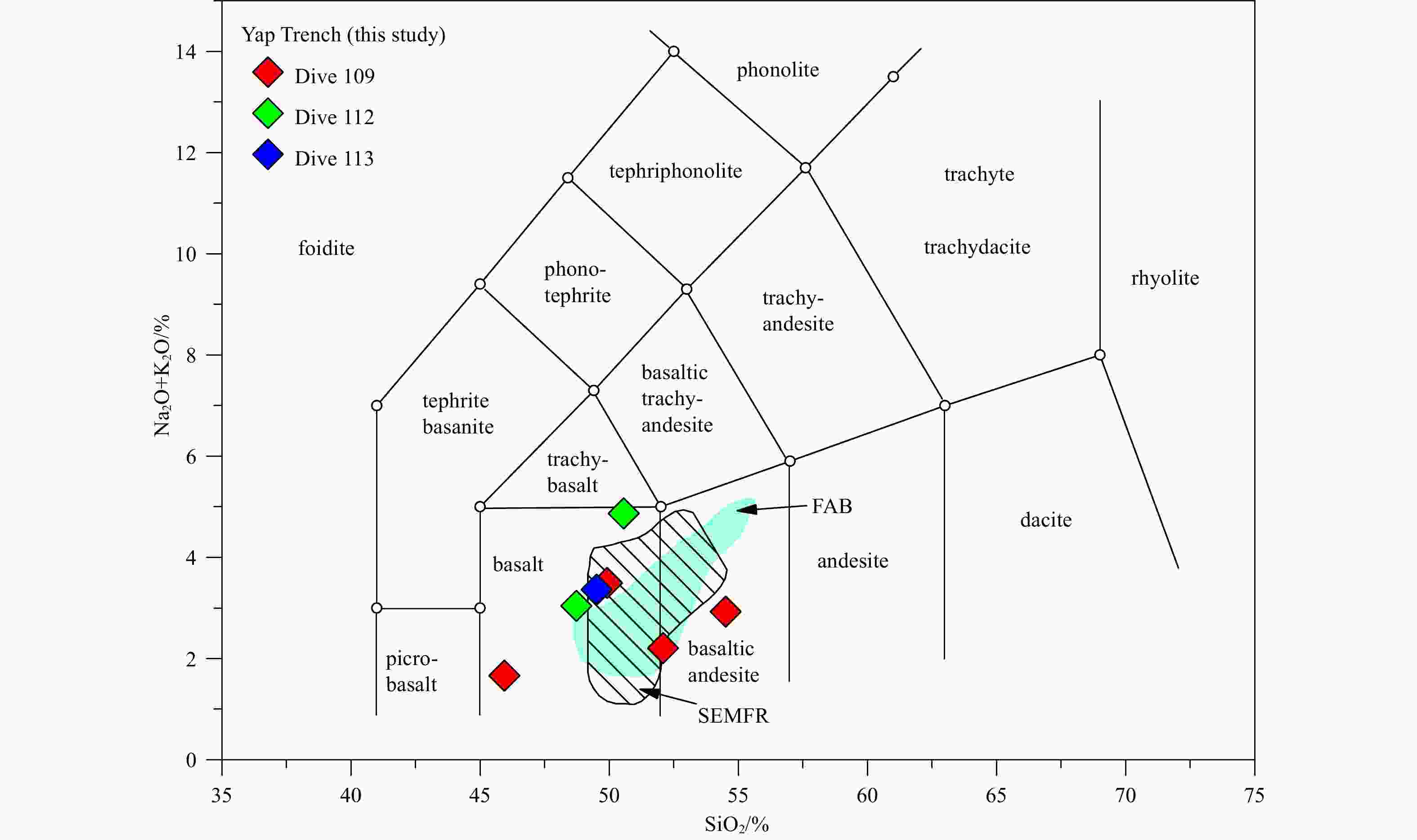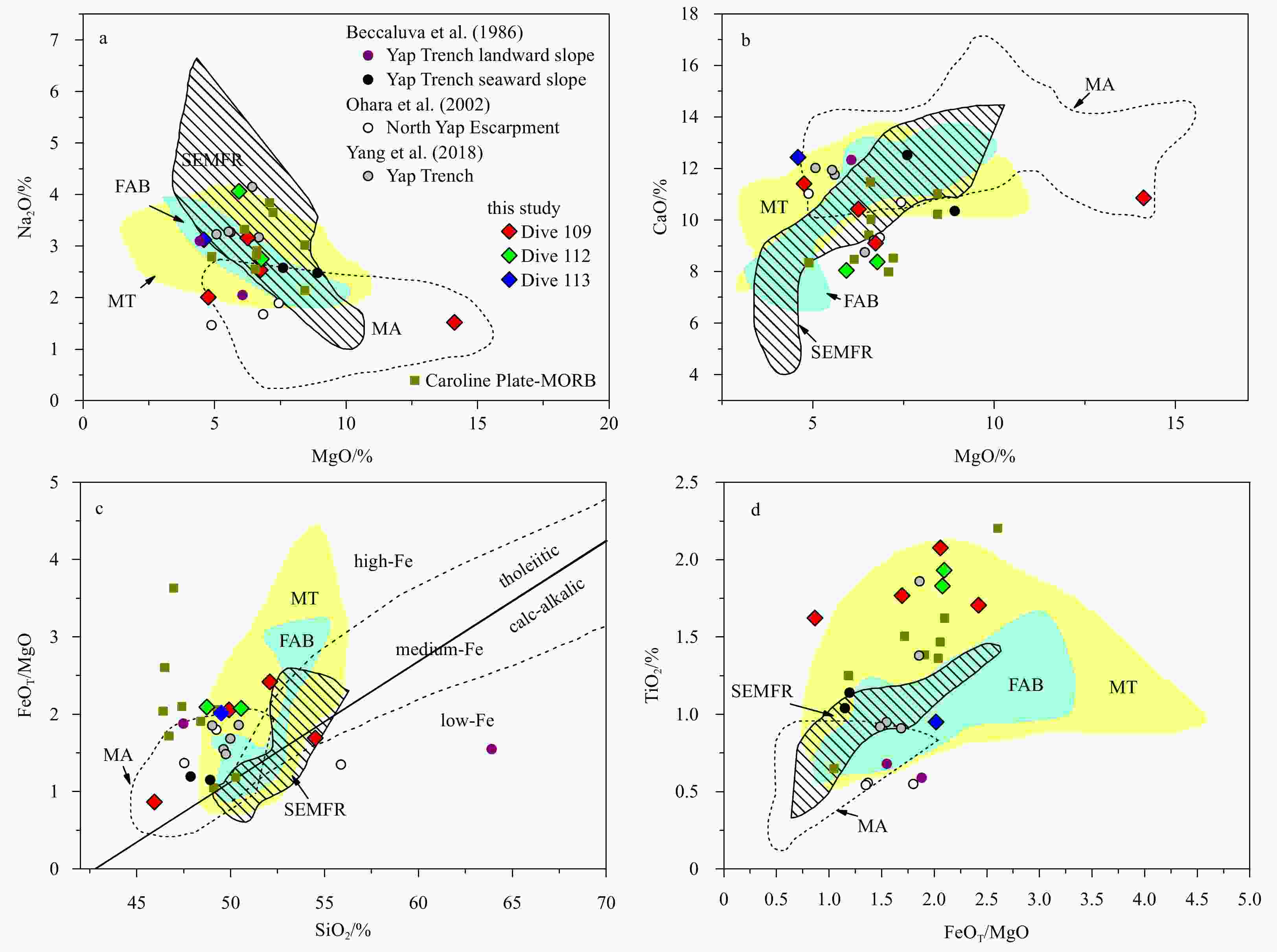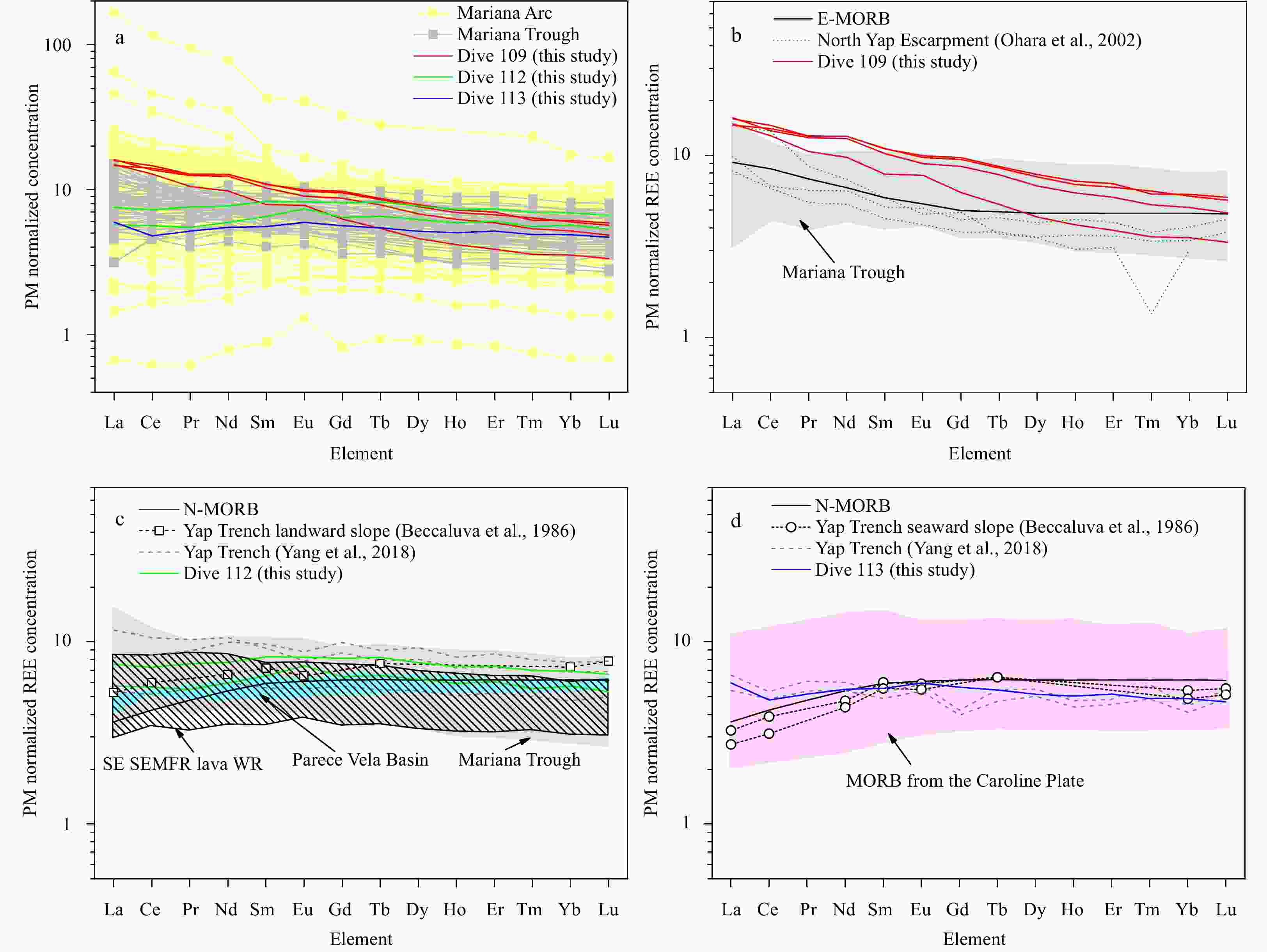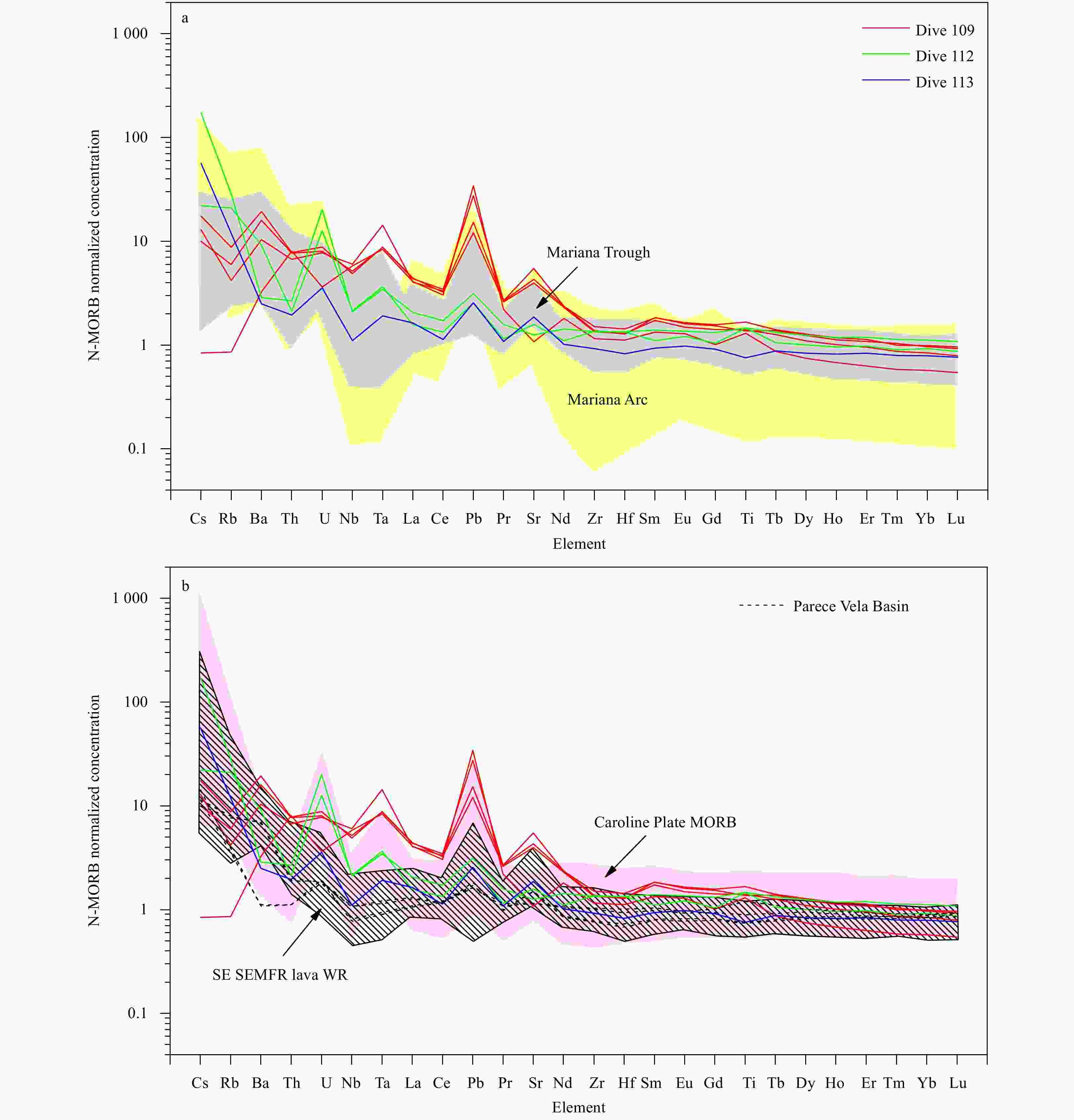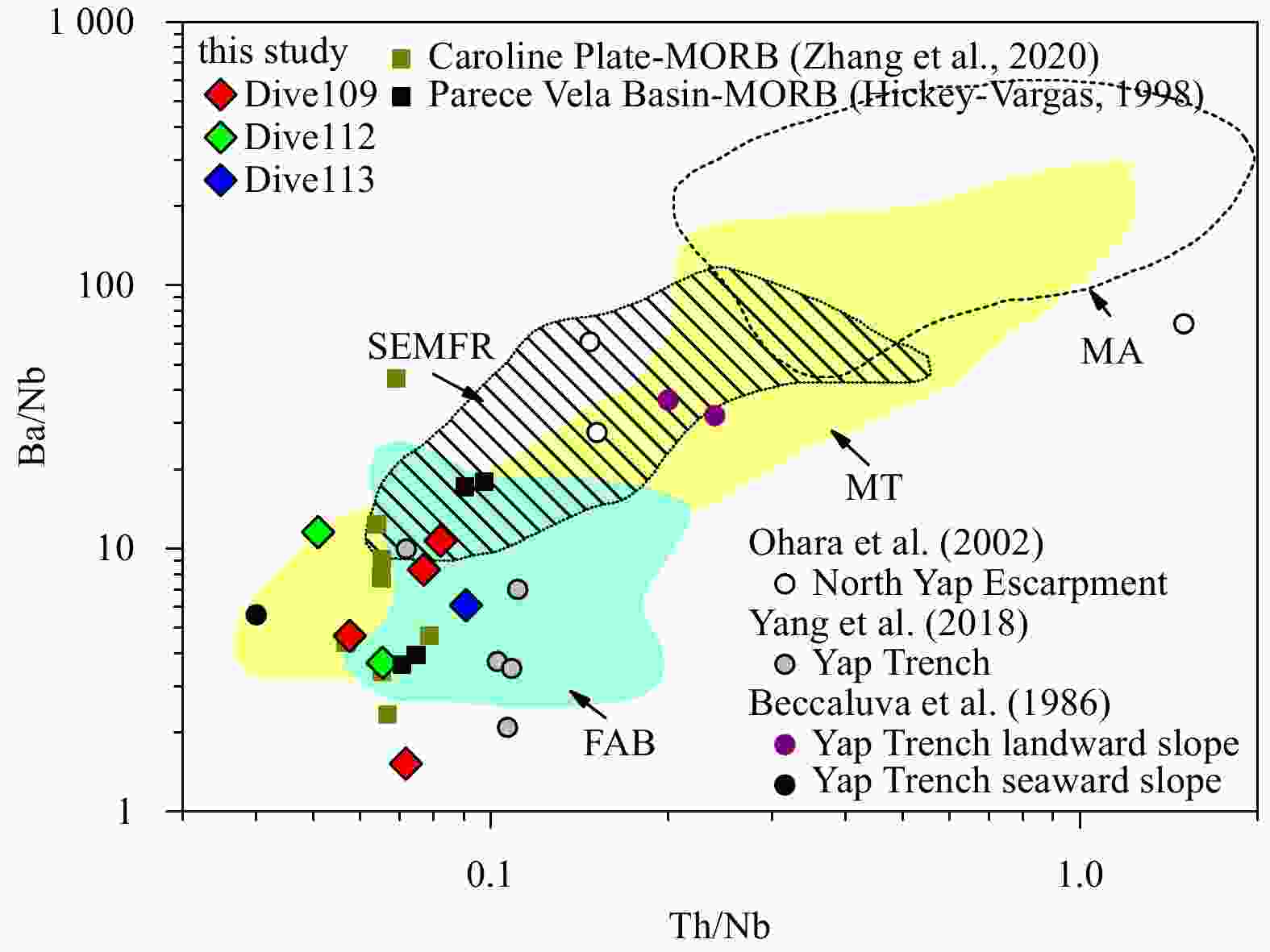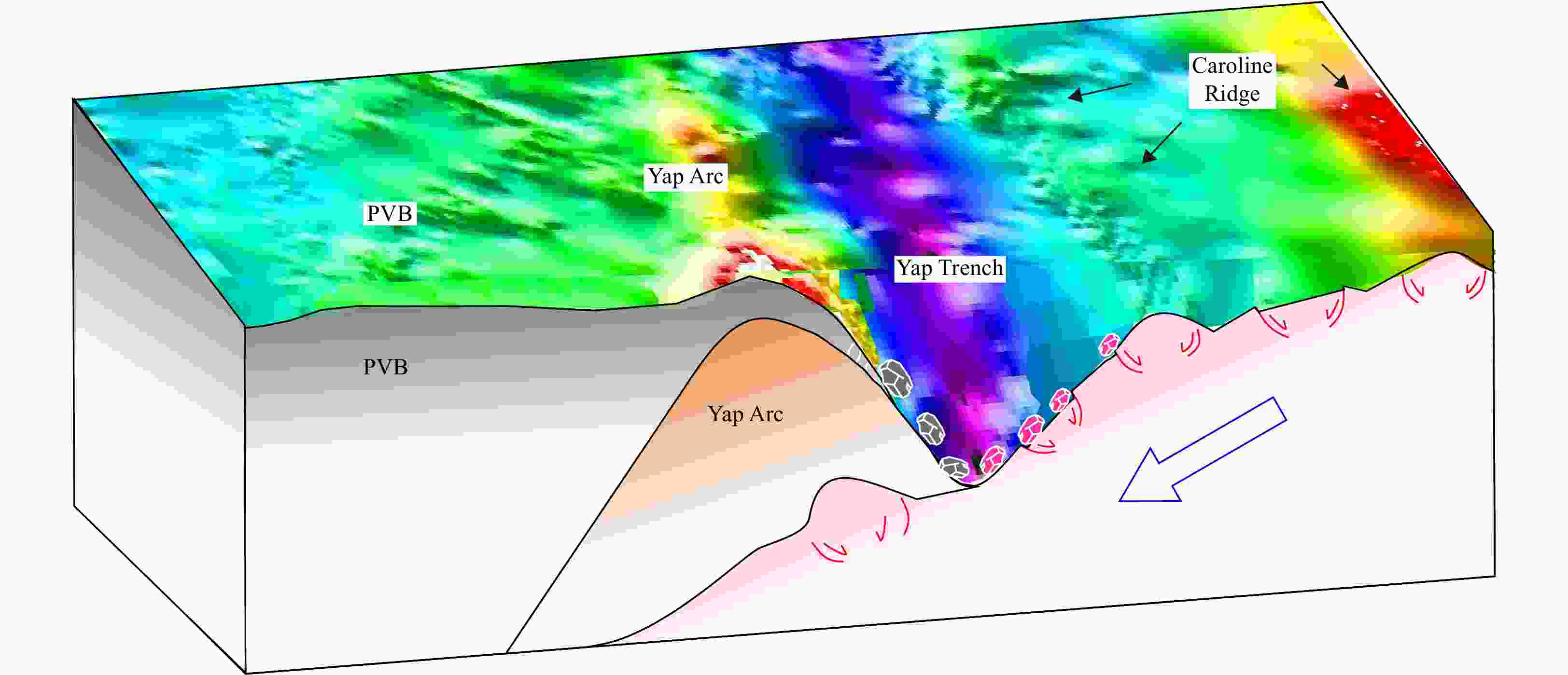Petrogenesis and tectonic implication of lavas from the Yap Trench, western Pacific
-
Abstract: We present major and trace element data of lava recovered from the northern Yap Trench in the western Pacific and discuss their petrogenesis and tectonic implications within the framework of interactions between the Caroline Ridge and Yap Trench. Rocks were collected from both landward and seaward trench slopes and exhibited geochemical characteristics similar to backarc basin basalt (BABB) and mid-ocean ridge basalt (MORB), including high Fe content, tholeiitic affinity, high TiO2 value at a given FeOT/MgO ratio, Ti/V ratio between 20 and 50, low Ba/Nb ratio and Th/Nb ratio, and trace element patterns commonly displayed by BABB and MORB, which are distinct from arc lava. These rocks seem to have been generated during mantle upwelling and decompression melting at a spreading center. However, compared with typical forearc lava produced by seafloor spreading in the Mariana forearc region, such as the early Eocene forearc basalts and late Neogene forearc lava in the southernmost Mariana Trench, the Yap Trench lava is derived from a more fertile mantle and feature a more minor subduction component; thus, they cannot be the products of forearc mantle decompression melting. We suggest that the landward slope lava represents backarc basin crust that was overthrust onto the forearc lithosphere during the collision of the Caroline Ridge with the Yap Trench (20–25 Ma), which played a key role in the evolution of the Yap subduction system. Moreover, the seaward slope lava represents the subduction plate crust that accreted onto the deep trench during the collision. This collision event resulted in the cessation of Yap Arc magmatism; thus, the Yap Trench volcanic rocks (<25 Ma) previously suggested to be arc magma products may actually represent the nascent island arc lava with a lower subduction component than in the mature Mariana Arc lava.
-
Key words:
- subduction zone /
- Yap Trench /
- forearc magmatism /
- subduction component /
- ridge subduction
-
Figure 1. Elevation and tectonic features of the study area (a) and detailed bathymetry around the sampling stations (b). Dive 109 in b includes 3 stations, which overlapped in map due to close distance. Refer to Table 1 for detailed longitude and latitude information.
Figure 3. SiO2 vs. Na2O + K2O diagram of the studied Yap Trench lava samples (after Le Bas et al., 1986). Lavas from the southeast Mariana forearc rift (SEMFR) (Ribeiro et al., 2013b) and typical forearc basalts (FAB) (Reagan et al., 2010) are shown for comparison.
Figure 4. MgO vs. Na2O (a), MgO vs. CaO (b), SiO2 vs. FeOT/MgO (c), and FeOT/MgO vs. TiO2 (d) diagrams of the studied lava. The solid line and dashed lines in c distinguish the tholeiite and calc-alkaline suites (Miyashiro, 1974) and high-, medium-, and low-Fe suites (Arculus, 2003), respectively. Mid-ocean ridge basalt (MORB) samples dredged from the Caroline Plate are shown for comparison (Fornari et al., 1979; Zhang et al., 2020). The fields indicate lavas from the Mariana Arc (MA) (Stern et al., 2006; Tamura et al., 2014; Ikeda et al., 2016), Mariana Trough (MT) (Sinton and Fryer, 1987; Hawkins et al., 1990; Stern et al., 1990; Gribble et al., 1996, 1998; Ikeda et al., 2016), southeast Mariana forearc rift (SEMFR) (Ribeiro et al., 2013b), and typical forearc basalts (FAB) (Reagan et al., 2010). Other data sources are shown in the legend.
Figure 5. Ti vs. V diagram of the studied Yap Trench lava. Lines of constant Ti/V distinguish arc lava (Ti/V < 20), backarc basin basalt (BABB), and mid-ocean ridge basalt (MORB) (20 ≤ Ti/V < 50), and ocean island basalt (OIB) (50 ≤ Ti/V < 100) (Shervais, 1982). Data sources are the same as in Fig. 3.
Figure 6. Primitive mantle (PM)-normalized rare earth element (REE) concentrations of the studied lava. Lava data from the Mariana Arc (Turner and Langmuir, 2015; Ikeda et al., 2016) and Mariana Trough (Gale et al., 2013; Ikeda et al., 2016) are shown. Field of the whole-rock data of the southeast southeast SEMFR lava (SE SEMFR lave WR) is obtained from Ribeiro et al. (2013b). Field of the N-MORB-type back-arc basin basalts in the Parece Vela Basin is obtained from Hickey-Vargas (1998). Field of the MORB-type basalts from the Caroline Plate is obtained from Zhang et al. (2020). Data for PM, N-MORB, and E-MORB are obtained from Sun and McDonough (1989). Other data sources are shown in the legend. SEMFR: southeast Mariana forearc rift, MORB: mid-ocean ridge basalt.
Figure 7. N-MORB-normalized trace element diagram of the studied Yap Trench lavas. Fields of the Mariana Arc (Turner and Langmuir, 2015; Ikeda et al., 2016) and Mariana Trough (Gale et al., 2013; Ikeda et al., 2016) are shown for comparison. Field of the whole-rock data of the southeast SEMFR lava (SE SEMFR lava WR) is obtained from Ribeiro et al. (2013b). Field of the N-MORB-type basalts from the Caroline Plate is obtained from Zhang et al. (2020). Data of the N-MORB-type back-arc basin basalts in the Parece Vela Basin are obtained from Hickey-Vargas (1998). N-MORB data are obtained from Sun and McDonough (1989). SEMFR: southeast Mariana forearc rift, MORB: mid-ocean ridge basalt.
Figure 8. Th/Nb vs. Ba/Nb diagram of the studied lava. Fields show lavas from the Mariana Arc (MA) (Stern et al., 2006; Tamura et al., 2014; Ikeda et al., 2016), Mariana Trough (MT) (Hawkins et al., 1990; Stern et al., 1990; Gribble et al., 1998; Pearce et al., 2005; Ikeda et al., 2016), southeast Mariana forearc rift (SEMFR) (Ribeiro et al., 2013b), and typical forearc basalts (FAB) (Reagan et al., 2010). Other data sources are shown in the legend. MORB: mid-ocean ridge basalt.
Figure 9. Nb/Yb vs. Ba/Yb (a) and Nb/Yb vs. Th/Yb (b) diagrams of the studied lava. Fields show lavas from the Mariana Arc (MA) (Stern et al., 2006; Tamura et al., 2014; Ikeda et al., 2016), Mariana Trough (MT) (Hawkins et al., 1990; Stern et al., 1990; Gribble et al., 1998; Pearce et al., 2005; Ikeda et al., 2016), southeast Mariana forearc rift (SEMFR) (Ribeiro et al., 2013b), and typical forearc basalt (FAB) (Reagan et al., 2010). Other data sources are shown in the legend.
Figure 10. Schematic showing overthrust of the Parece Vela Basin (PVB) crust onto the Yap Arc and forearc area due to the collision of the Caroline Ridge with the trench. Gray blocks indicate back-arc crustal rocks presented in the deep trench due to the overthrust of the Parece Vela Basin crust and landslides of the landward trench slope, and pink blocks indicate the volcanic lava exposed on the seafloor through faulting in the horst and graben (red arrows) on the subduction plate. Blue arrow indicates the subduction direction.
Table 1. Whole-rock major element and trace element concentrations in lavas from the Yap Trench
Sample ID GBW07316 AGV-2 Dive
109-S02-1Dive
109-S03-1Dive
109-S05-1Dive
109-S05-2Dive
112-S03-1Dive
112-S08-1Dive
113-S02-1Dive station Dive 109-S02 Dive 109-S03 Dive 109-S05 Dive 112-S03 Dive 112-S08 Dive 113-S02 East longitude/(°) 138.402 700 138.402 000 138.401 900 138.496 000 138.479 000 138.655 000 North latitude/(°) 9.899 317 9.899 570 9.900 149 9.865 550 9.868 830 9.865 850 Major element SiO2/% 45.94 49.91 54.50 52.08 50.55 48.73 49.50 31.21 TiO2/% 1.62 2.08 1.77 1.71 1.83 1.93 0.95 0.37 Al2O3/% 11.73 13.26 11.82 13.75 13.29 12.97 17.75 7.89 TFe2O3/% 12.21 12.86 11.39 11.51 12.30 14.18 9.24 3.70 MnO/% 0.19 0.20 0.18 0.16 0.20 0.32 0.12 0.41 MgO/% 14.12 6.25 6.73 4.76 5.92 6.77 4.59 2.07 CaO/% 10.86 10.43 9.10 11.41 8.05 8.37 12.43 22.35 Na2O/% 1.52 3.16 2.54 2.01 4.06 2.75 3.12 3.91 K2O/% 0.14 0.34 0.39 0.20 0.81 0.29 0.24 1.54 P2O5/% 0.01 0.21 0.18 0.18 0.09 0.14 0.13 0.32 LOI/% 1.17 0.63 0.90 1.29 2.98 1.98 1.11 25.80 Sum/% 99.51 99.32 99.50 99.04 100.07 98.44 99.19 99.56 Trace element Li/10−6 3.1 4.6 4.7 4.1 22.3 29.7 10.9 10.6 Ti/10−6 9 891 12 648 10 691 10 373 11 059 11 142 5 744 6 225 V/10−6 327 392 340 354 464 452 236 118 Rb/10−6 0.481 3.348 4.886 2.355 11.737 15.96 6.701 67.470 Sr/10−6 97 387 358 492 143 112 168 659 Y/10−6 18.5 31.9 27.1 31.3 26.7 31.8 24.1 19.9 Zr/10−6 85.2 111.0 99.5 101.6 100.9 99.6 68.2 231.3 Nb/10−6 13.50 12.05 11.40 14.00 5.00 4.92 2.57 14.31 Cs/10−6 0.006 0.07 0.123 0.09 0.155 1.218 0.398 1.082 Ba/10−6 20.6 100.4 122.3 65.2 57.7 18.1 15.7 1 115.3 La/10−6 10.23 10.9 11.07 10.08 3.94 5.17 4.09 38.05 Ce/10−6 22.7 25.9 24.3 24.9 10.0 12.9 8.5 69.1 Pr/10−6 2.90 3.52 3.45 3.53 1.51 2.10 1.43 8.12 Nd/10−6 13.22 17.26 16.75 17.23 8.05 10.45 7.44 30.22 Sm/10−6 3.499 4.827 4.546 4.846 2.894 3.677 2.466 5.639 Eu/10−6 1.308 1.672 1.514 1.636 1.24 1.384 0.998 1.524 Gd/10−6 3.726 5.801 5.193 5.66 3.835 4.844 3.359 4.496 Tb/10−6 0.582 0.939 0.846 0.922 0.707 0.888 0.588 0.615 Dy/10−6 3.383 5.796 5.005 5.624 4.580 5.672 3.800 3.500 Ho/10−6 0.682 1.185 1.021 1.136 0.968 1.198 0.826 0.655 Er/10−6 1.862 3.358 2.829 3.211 2.903 3.528 2.480 1.840 Tm/10−6 0.265 0.454 0.397 0.472 0.410 0.515 0.362 0.259 Yb/10−6 1.743 3.015 2.556 2.945 2.812 3.404 2.408 1.653 Lu/10−6 0.247 0.436 0.359 0.42 0.394 0.491 0.347 0.254 Hf/10−6 2.295 2.936 2.646 2.618 2.744 2.757 1.687 5.243 Ta/10−6 1.108 1.155 1.161 1.891 0.481 0.455 0.252 0.853 Pb/10−6 10.30 8.24 3.63 4.57 0.77 0.94 0.77 13.13 Th/10−6 0.969 0.928 0.937 0.806 0.255 0.322 0.234 6.232 U/10−6 0.170 0.377 0.414 0.365 0.594 0.948 0.168 1.789 Note: LOI means loss on ignition. Measured major element contents for reference materials GBW07316 and trace element contents for reference materials AGV-2 are also presented. -
[1] Arculus R J. 2003. Use and abuse of the terms calcalkaline and calcalkalic. Journal of Petrology, 44(5): 929–935. doi: 10.1093/petrology/44.5.929 [2] Beccaluva L, Macciotta G, Savelli C, et al. 1980. Geochemistry and K/Ar ages of volcanics dredged in the Philippine Sea (Mariana, Yap, and Palau trenches and Parece Vela Basin). In: Hayes D E, ed. The Tectonic and Geologic Evolution of Southeast Asian Seas and Islands. Washington, DC, USA: American Geophysical Union, 247–268 [3] Beccaluva L, Serri G, Dostal J. 1986. Geochemistry of volcanic rocks from the Mariana, Yap and Palau trenches bearing on the tectono-magmatic evolution of the Mariana trench-arc-backarc system. Developments in Geotectonics, 21: 481–508 [4] Bracey D R. 1975. Reconnaissance geophysical survey of the Caroline Basin. Geological Society of America Bulletin, 86(6): 775–784. doi: 10.1130/0016-7606(1975)86<775:RGSOTC>2.0.CO;2 [5] Chen Ling, Tang Limei, Li Xiaohu, et al. 2019a. Geochemistry of peridotites from the Yap Trench, Western Pacific: implications for subduction zone mantle evolution. International Geology Review, 61(9): 1037–1051. doi: 10.1080/00206814.2018.1484305 [6] Chen Ling, Tang Limei, Li Xiaohu, et al. 2019b. Ancient melt depletion and metasomatic history of the subduction zone mantle: osmium isotope evidence of peridotites from the Yap Trench, Western Pacific. Minerals, 9(12): 717. doi: 10.3390/min9120717 [7] Crawford A J, Beccaluva L, Serri G, et al. 1986. Petrology, geochemistry and tectonic implications of volcanics dredged from the intersection of the Yap and Mariana trenches. Earth and Planetary Science Letters, 80(3–4): 265–280 [8] Crawford A J, Falloon T J, Green D H. 1989. Classification, petrogenesis and tectonic setting of boninites. In: Crawford A J, ed. Boninites and related Rocks, Unwin and Hyman. London: UTAS, 1–49 [9] Dilek Y, Furnes H, Shallo M. 2008. Geochemistry of the Jurassic Mirdita Ophiolite (Albania) and the MORB to SSZ evolution of a marginal basin oceanic crust. Lithos, 100(1–4): 174–209 [10] Dong Dongdong, Zhang Zhengyi, Bai Yongliang, et al. 2018. Topographic and sedimentary features in the Yap subduction zone and their implications for the Caroline Ridge subduction. Tectonophysics, 722: 410–421. doi: 10.1016/j.tecto.2017.11.030 [11] Elliott T, Plank T, Zindler A, et al. 1997. Element transport from slab to volcanic front at the Mariana arc. Journal of Geophysical Research: Solid Earth, 102(B7): 14991–15019. doi: 10.1029/97JB00788 [12] Fornari D J, Weissel J K, Perfit M R, et al. 1979. Petrochemistry of the Sorol and Ayu Troughs: implications for crustal accretion at the northern and western boundaries of the Caroline Plate. Earth and Planetary Science Letters, 45(1): 1–15. doi: 10.1016/0012-821X(79)90102-X [13] Fujiwara T, Tamura C, Nishizawa A, et al. 2000. Morphology and tectonics of the Yap Trench. Marine Geophysical Researches, 21(1): 69–86 [14] Gaina C, Müller D. 2007. Cenozoic tectonic and depth/age evolution of the Indonesian gateway and associated back-arc basins. Earth-Science Reviews, 83(3–4): 177–203 [15] Gale A, Dalton C A, Langmuir C H, et al. 2013. The mean composition of ocean ridge basalts. Geochemistry, Geophysics, Geosystems, 14(3): 489–518. doi: 10.1029/2012GC004334 [16] Gribble R F, Stern R J, Bloomer S H, et al. 1996. MORB mantle and subduction components interact to generate basalts in the southern Mariana Trough back-arc basin. Geochimica et Cosmochimica Acta, 60(12): 2153–2166. doi: 10.1016/0016-7037(96)00078-6 [17] Gribble R F, Stern R J, Newman S, et al. 1998. Chemical and isotopic composition of lavas from the northern Mariana Trough: Implications for magmagenesis in back-arc basins. Journal of Petrology, 39(1): 125–154. doi: 10.1093/petroj/39.1.125 [18] Hawkesworth C J, Turner S P, McDermott F, et al. 1997. U-Th isotopes in arc magmas: implications for element transfer from the subducted crust. Science, 276(5312): 551–555. doi: 10.1126/science.276.5312.551 [19] Hawkins J, Batiza R. 1977. Metamorphic rocks of the Yap Arc-Trench system. Earth and Planetary Science Letters, 37(2): 216–229. doi: 10.1016/0012-821X(77)90166-2 [20] Hawkins J W, Lonsdale P F, Macdougall J D, et al. 1990. Petrology of the axial ridge of the Mariana Trough backarc spreading center. Earth and Planetary Science Letters, 100(1–3): 226–250 [21] Hegarty K A, Weissel J K. 1988. Complexities in the development of the Caroline Plate region, western equatorial Pacific. In: Nairn A E M, Stehli F G, Uyeda S, eds. The Ocean Basins and Margins. Boston: Springer, 277–301 [22] Hickey-Vargas R. 1998. Origin of the Indian Ocean-type isotopic signature in basalts from Philippine Sea plate spreading centers: An assessment of local versus large-scale processes. Journal of Geophysical Research: Solid Earth, 103(B9): 20963–20979. doi: 10.1029/98JB02052 [23] Hulme S M, Wheat C G, Fryer P, et al. 2010. Pore water chemistry of the Mariana serpentinite mud volcanoes: a window to the seismogenic zone. Geochemistry, Geophysics, Geosystems, 11(1): Q01X09 [24] Ikeda Y, Nagao K, Ishii T, et al. 2016. Contributions of slab fluid and sediment melt components to magmatism in the Mariana Arc-Trough system: evidence from geochemical compositions and Sr, Nd, and noble gas isotope systematics. Island Arc, 25(4): 253–273. doi: 10.1111/iar.12150 [25] Ishizuka O, Hickey-Vargas R, Arculus R J, et al. 2018. Age of Izu–Bonin–Mariana arc basement. Earth and Planetary Science Letters, 481: 80–90. doi: 10.1016/j.jpgl.2017.10.023 [26] Ishizuka O, Kimura J I, Li Y B, et al. 2006. Early stages in the evolution of Izu–Bonin arc volcanism: new age, chemical, and isotopic constraints. Earth and Planetary Science Letters, 250(1–2): 385–401 [27] Ishizuka O, Taylor R N, Yuasa M, et al. 2011. Making and breaking an island arc: a new perspective from the Oligocene Kyushu–Palau arc, Philippine Sea. Geochemistry, Geophysics, Geosystems, 12(5): Q05005 [28] Keating B H, Mattey D P, Helsley C E, et al. 1984. Evidence for a hot spot origin of the Caroline Islands. Journal of Geophysical Research: Solid Earth, 89(B12): 9937–9948. doi: 10.1029/JB089iB12p09937 [29] Kobayashi K. 2000. Horizontally-moving subducted slab may generate enigmatic features of the Palau and Yap Trench-Arcs. Proceedings of the Japan Academy, Series B, 76(9): 133–138. doi: 10.2183/pjab.76.133 [30] Kobayashi K. 2004. Origin of the Palau and Yap Trench-Arc systems. Geophysical Journal International, 157(3): 1303–1315. doi: 10.1111/j.1365-246X.2003.02244.x [31] Le Bas M L, Le Maitre R W, Streckeisen A, et al. 1986. A chemical classification of volcanic rocks based on the total alkali-silica diagram. Journal of Petrology, 27(3): 745–750. doi: 10.1093/petrology/27.3.745 [32] Lee S M. 2004. Deformation from the convergence of oceanic lithosphere into Yap Trench and its implications for early-stage subduction. Journal of Geodynamics, 37(1): 83–102. doi: 10.1016/j.jog.2003.10.003 [33] Li Hongyan, Taylor R N, Prytulak J, et al. 2019. Radiogenic isotopes document the start of subduction in the Western Pacific. Earth and Planetary Science Letters, 518: 197–210. doi: 10.1016/j.jpgl.2019.04.041 [34] Liu Feng, Cui Weicheng, Li Xiangyang. 2010. China’s first deep manned submersible, JIAOLONG. Science China Earth Sciences, 53(10): 1407–1410. doi: 10.1007/s11430-010-4100-2 [35] Martinez F, Stern R J, Kelley K A, et al. 2018. Diffuse extension of the southern Mariana margin. Journal of Geophysical Research: Solid Earth, 123(1): 892–916. doi: 10.1002/2017JB014684 [36] McCabe R, Uyeda S. 1983. Hypothetical model for the bending of the Mariana Arc. In: Hayes D E, ed. The Tectonic and Geologic Evolution of Southeast Asian Seas and Islands. Washington, DC, USA: American Geophysical Union, 281–293 [37] Meijer A, Reagan M, Ellis H, et al. 1983. Chronology of volcanic events in the eastern Philippine Sea. In: Hayes D E, ed. The Tectonic and Geologic Evolution of Southeast Asian Seas and Islands. Washington: American Geophysical Union, 349–359 [38] Miyashiro A. 1974. Volcanic rock series in island arcs and active continental margins. American Journal of Science, 274(4): 321–355. doi: 10.2475/ajs.274.4.321 [39] Ohara Y, Fujioka K, Ishizuka O, et al. 2002. Peridotites and volcanics from the Yap Arc system: implications for tectonics of the southern Philippine Sea Plate. Chemical Geology, 189(1–2): 35–53 [40] Okino K, Kasuga S, Ohara Y. 1998. A new scenario of the Parece Vela Basin genesis. Marine Geophysical Researches, 20(1): 21–40. doi: 10.1023/A:1004377422118 [41] Parkinson I J, Hawkesworth C J, Cohen A S. 1998. Ancient mantle in a modern arc: osmium isotopes in Izu-Bonin-Mariana forearc peridotites. Science, 281(5385): 2011–2013. doi: 10.1126/science.281.5385.2011 [42] Pearce J A, Stern R J, Bloomer S H, et al. 2005. Geochemical mapping of the Mariana arc-basin system: Implications for the nature and distribution of subduction components. Geochemistry, Geophysics, Geosystems, 6(7): Q07006 [43] Pearce J A, Van Der Laan S R, Arculus R J, et al. 1992. Boninite and harzburgite from Leg 125 (Bonin-Mariana forearc): a case study of magma genesis during the initial stages of subduction. In: Proceedings of the ocean drilling program scientific results. College Station, TX, USA: A&M University, 623–659 [44] Reagan M K, Heaton D E, Schmitz M D, et al. 2019. Forearc ages reveal extensive short-lived and rapid seafloor spreading following subduction initiation. Earth and Planetary Science Letters, 506: 520–529. doi: 10.1016/j.jpgl.2018.11.020 [45] Reagan M K, Ishizuka O, Stern R J, et al. 2010. Fore-arc basalts and subduction initiation in the Izu-Bonin-Mariana system. Geochemistry, Geophysics, Geosystems, 11(3): Q03X12 [46] Reagan M K, McClelland W C, Girard G, et al. 2013. The geology of the southern Mariana fore-arc crust: Implications for the scale of Eocene volcanism in the western Pacific. Earth and Planetary Science Letters, 380: 41–51. doi: 10.1016/j.jpgl.2013.08.013 [47] Ribeiro J M, Ishizuka O, Lee C T A, et al. 2020. Evolution and maturation of the nascent Mariana arc. Earth and Planetary Science Letters, 530: 115912. doi: 10.1016/j.jpgl.2019.115912 [48] Ribeiro J M, Stern R J, Kelley K A, et al. 2013a. Nature and distribution of slab-derived fluids and mantle sources beneath the Southeast Mariana forearc rift. Geochemistry, Geophysics, Geosystems, 14(10): 4585–4607. doi: 10.1002/ggge.20244 [49] Ribeiro J M, Stern R J, Martinez F, et al. 2013b. Geodynamic evolution of a forearc rift in the southernmost Mariana Arc. Island Arc, 22(4): 453–476. doi: 10.1111/iar.12039 [50] Sato T, Kasahara J, Katao H, et al. 1997. Seismic observations at the Yap Islands and the northern Yap Trench. Tectonophysics, 271(3–4): 285–294 [51] Sdrolias M, Roest W R, Müller R D. 2004. An expression of Philippine Sea plate rotation: the Parece vela and shikoku basins. Tectonophysics, 394(1–2): 69–86 [52] Seno T, Stein S, Gripp A E. 1993. A model for the motion of the Philippine Sea plate consistent with NUVEL-1 and geological data. Journal of Geophysical Research: Solid Earth, 98(B10): 17941–17948. doi: 10.1029/93JB00782 [53] Shervais J W. 1982. Ti-V plots and the petrogenesis of modern and ophiolitic lavas. Earth and Planetary Science Letters, 59(1): 101–118. doi: 10.1016/0012-821X(82)90120-0 [54] Shervais J W, Reagan M, Haugen E, et al. 2019. Magmatic response to subduction initiation: Part 1. Fore-arc basalts of the Izu-Bonin arc from IODP Expedition 352. Geochemistry, Geophysics, Geosystems, 20(1): 314–338. doi: 10.1029/2018GC007731 [55] Shiraki K. 1971. Metamorphic basement rocks of Yap Islands, western Pacific: possible oceanic crust beneath an island arc. Earth and Planetary Science Letters, 13(1): 167–174. doi: 10.1016/0012-821X(71)90120-8 [56] Sinton J M, Fryer P. 1987. Mariana Trough lavas from 18°N: implications for the origin of back arc basin basalts. Journal of Geophysical Research: Solid Earth, 92(B12): 12782–12802. doi: 10.1029/JB092iB12p12782 [57] Stern R J, Bloomer S H. 1992. Subduction zone infancy: examples from the Eocene Izu-Bonin-Mariana and Jurassic California arcs. Geological Society of America Bulletin, 104(12): 1621–1636. doi: 10.1130/0016-7606(1992)104<1621:SZIEFT>2.3.CO;2 [58] Stern R J, Gerya T. 2018. Subduction initiation in nature and models: a review. Tectonophysics, 746: 173–198. doi: 10.1016/j.tecto.2017.10.014 [59] Stern R J, Kohut E, Bloomer S H, et al. 2006. Subduction factory processes beneath the Guguan cross-chain, Mariana Arc: no role for sediments, are serpentinites important?. Contributions to Mineralogy and Petrology, 151(2): 202–221. doi: 10.1007/s00410-005-0055-2 [60] Stern R J, Lin Pingnan, Morris J D, et al. 1990. Enriched back-arc basin basalts from the northern Mariana Trough: implications for the magmatic evolution of back-arc basins. Earth and Planetary Science Letters, 100(1–3): 210–225 [61] Stern R J, Ren Minghua, Kelley K A, et al. 2014. Basaltic volcaniclastics from the Challenger Deep forearc segment, Mariana convergent margin: Implications for tectonics and magmatism of the southernmost Izu–Bonin–Mariana arc. Island Arc, 23(4): 368–382. doi: 10.1111/iar.12088 [62] Sun S S, McDonough W F. 1989. Chemical and isotopic systematics of oceanic basalts: implications for mantle composition and processes. Geological Society Special Publication, 42(1): 313–345. doi: 10.1144/GSL.SP.1989.042.01.19 [63] Tamura Y, Ishizuka O, Stern R J, et al. 2014. Mission immiscible: distinct subduction components generate two primary magmas at pagan volcano, Mariana arc. Journal of Petrology, 55(1): 63–101. doi: 10.1093/petrology/egt061 [64] Turner S J, Langmuir C H. 2015. The global chemical systematics of arc front stratovolcanoes: Evaluating the role of crustal processes. Earth and Planetary Science Letters, 422: 182–193. doi: 10.1016/j.jpgl.2015.03.056 [65] Van Keken P E, Kiefer B, Peacock S M. 2002. High-resolution models of subduction zones: Implications for mineral dehydration reactions and the transport of water into the deep mantle. Geochemistry, Geophysics, Geosystems, 3(10): 1056 [66] Wada I, Rychert C A, Wang Kelin. 2011. Sharp thermal transition in the forearc mantle wedge as a consequence of nonlinear mantle wedge flow. Geophysical Research Letters, 38(13): L13308 [67] Whattam S A, Stern R J. 2011. The ‘subduction initiation rule’: a key for linking ophiolites, intra-oceanic forearcs, and subduction initiation. Contributions to Mineralogy and Petrology, 162(5): 1031–1045. doi: 10.1007/s00410-011-0638-z [68] Yamazaki T, Kikawa E, Murakami F, et al. 1994. Spreading mode of the West Caroline Basin deduced from magnetic vector anomalies. Journal of Geomagnetism and Geoelectricity, 46(6): 443–453. doi: 10.5636/jgg.46.443 [69] Yang Yaomin, Wu Shiguo, Gao Jinwei, et al. 2018. Geology of the Yap Trench: new observations from a transect near 10°N from manned submersible Jiaolong. International Geology Review, 60(16): 1941–1953. doi: 10.1080/00206814.2017.1394226 [70] Zhang Zhengyi, Dong Dongdong, Sun Weidong, et al. 2019. Subduction Erosion, crustal structure, and an evolutionary model of the northern yap subduction zone: new observations from the latest geophysical survey. Geochemistry, Geophysics, Geosystems, 20(1): 166–182. doi: 10.1029/2018GC007751 [71] Zhang Ji, Zhang Guoliang. 2020. Geochemical and chronological evidence for collision of proto-Yap Arc/Caroline Plateau and rejuvenated plate subduction at Yap Trench. Lithos, 370−371: 105616. doi: 10.1016/j.lithos.2020.105616 [72] Zhang Guoliang, Zhang Ji, Wang Shuai, et al. 2020. Geochemical and chronological constraints on the mantle plume origin of the Caroline Plateau. Chemical Geology, 540: 119566. doi: 10.1016/j.chemgeo.2020.119566 -





 下载:
下载:


